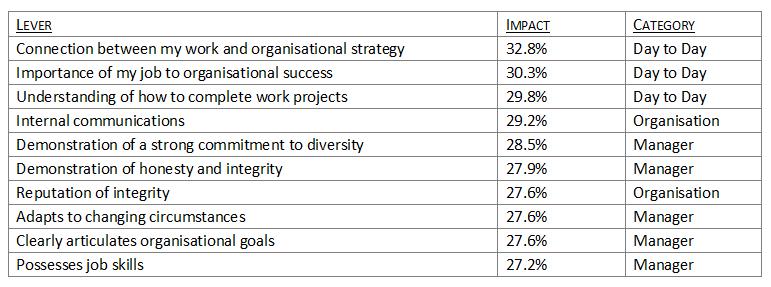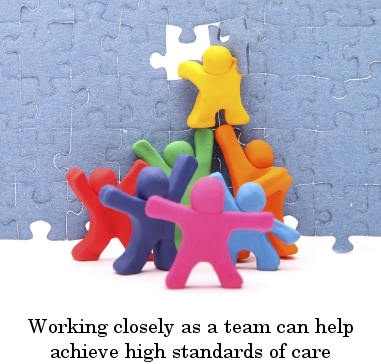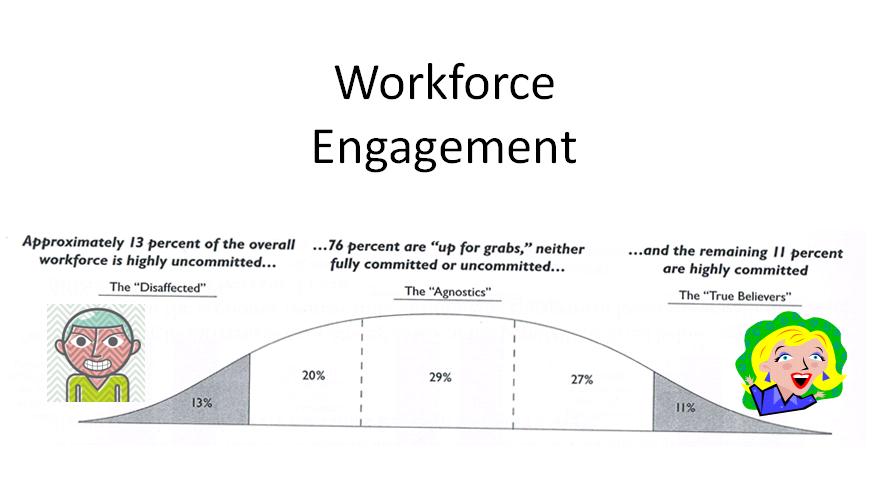Workforce Engagement
Workforce Engagement
The following article by Andrew McLachlan, the QPS consultant responsible for reviewing the Employee Satisfaction Survey in line with global research, describes what workforce engagement is and why it matters. Findings show engagement does work, it does work in aged care and it does make a difference.Global research by the Corporate Leadership Council of 50,000 employees, across 27 countries and 10 industries provides quantitative evidence that focused efforts to engage employees leads to their retention and improved performance.
Application of the research within a large Australian aged care provider demonstrates the applicability of the research in the Australian aged care context, dispelling some pervading myths and revealing some unanticipated findings.
In this article we explore workforce engagement - what it is and why it matters, and what to focus on in order to improve it.
Understanding Engagement
The Corporate Leadership Council definition of engagement is, "the extent to which employees commit to something or someone in their organisation and how hard they will work and how long they stay as a result of that commitment."
In understanding and applying workforce engagement research it holds that an organisation can be more focussed on its engagement initiatives and HR spend. Understanding is required into the types of employee commitment and what this commitment produces (the outputs) for the organisation.
There are two types of commitment which are:
- Rational Commitment - the extent to which employees believe their managers, teams, or organisations are in their self interest (financial, developmental, or professional), and
- Emotional Commitment - the extent to which employees value, enjoy and believe in their jobs, managers, teams, or organisations.
The outputs of employee commitment are:
- Discretionary Effort - An employee's willingness to go "above and beyond" the call of duty, such as helping others with heavy workloads, volunteering for additional duties, and looking for ways to perform their duties more effectively. Discretionary effort leads to improved employee performance.
- Intent to Stay - An employee's desire to stay with the organisation, based on whether they intend to look for a new job within a year, whether they frequently think of quitting, whether they are actively looking for a job or have begun to take tangible steps like placing phone calls or sending out resumes. Intent to stay leads to employee retention.

Having a highly engaged workforce means having a high proportion of employees who are committed to the organisation and to their manager, who will contribute ideas, and will go the extra mile for their residents, clients and teams members.
So what makes the difference in creating commitment?
Of the 300 engagement levers available, the majority will produce positive results of varying strength. That is to say, almost anything that you do to improve engagement will have some positive effect. The top levers however will have around forty times the impact of the lesser ones. As we want the best impact from our efforts it makes sense to focus on the levers shown to produce the best outcomes.
So the top ten engagement levers, along with the statistical estimate on their impact on discretionary effort, and their category, are as follows:

The 'Category' is the focal point of the lever for which there are six, being:
- Day to day work characteristics
- Organisational characteristics
- Direct Manager characteristics
- Learning & Development Opportunities
- Areas of Onboarding Focus
- Senior Executive Qualities
We observe that the top three ranking levers relate to characteristics of day-to-day work.
We also observe that characteristics of the manager feature the most in the top ten. In fact, the manager is more effective at creating commitment than any other person or group in the organisation. A manager is a strong conduit of change within an organisation but of course individual managers have the smallest span of control and limited scalability. They can only really engage their own staff.
What is also of interest is what does not feature in the top ten. Of the levers relating to compensation, the top ranking lever is 'connection between performance and pay increase' however even that lever doesn't even feature in the top 50 levers.

One aged care organisation sought to pursue workforce engagement as a key part of its overall strategy, applying the principles and findings from the research to its organisational human resources strategy.
The organisation, a large Australian not for profit aged care provider of residential care and community services with over 2000 employees, was typical of many in the sector with high employee turnover, escalating workers compensation premium, and difficulty in attracting and retaining employees especially registered nurses.
Over a five year period the organisation:
- reduced employee turnover from 22% to 11%
- reduced workers compensation premium from 4-5% of wages to 2%
- introduced career opportunity for carers
- overcame attraction difficulties, especially with RNs
Important in achieving these outcomes was the following:
- Measurement, initially and throughout the period, ensuring the right things were being measured in the right ways.
- Communication to employees regularly, focussing on employee survey results.
- Working closely with managers, providing support and coaching.
- Establishing an enterprise agreement which provided common terms and conditions to all employees and allowed configuration of classification and pay rates to best suit the organisation and employees.
- Planning for, and ensuring, outcome sustainability.
The survey of employees was an important part of measurement. Engagement research adds clarity to raw survey results, providing perspective of what is likely to have greatest impact on the overall increase in employee commitment.
There were five clear messages from this organisation's workforce. Employees wanted:
- To feel valued.
- For their ideas to count.
- Career progression.
- Better pay.
- Better communication.
Career progression initiatives provided progression opportunity for relatively few. Initiatives included programs to retain graduate nurses, and the establishment of extended carer roles with carers as skilled champions for dementia care and palliative care. Whilst only directly impacting a relative few, subsequent surveys showed that employees in general recognised this as positive. The improved employee retention meant greater experience on the floor and provided clinicians in residential care with carers they could trust and delegate to.
There is significance in workers compensation being considered a measure connected with engagement. Improving workers compensation premium by 2-3% of wages provides sustainable funding for the organisation and for the initiatives to drive further improvement. Workers compensation management success is very dependent upon the actions of managers.

The QPS Employee Satisfaction Tool was reviewed for year in line with this research. Questions have been added to specifically measure those aspects of engagement that both research and experience have demonstrated have a more significant impact on employee commitment and engagement.
Furthermore, by including some questions in common with other popular engagement surveys in use in the industry, organisations have a means of comparing their QPS results with results achieved using these other tools.
Conclusions
It is recognised that getting aged care workforce issues addressed is a top issue in ensuring sector sustainability, capability and productivity as needed to serve our ageing Australian population.
Workforce engagement ought to be the key focus of aged care providers. This helps ensure investment is directed towards the initiatives that will have the greatest impact in increasing employee commitment.

The Author, Andrew McLachlan
For the last decade Andrew McLachlan was on the Executive and headed up Human Resources for a large Australian not for profit organisation providing residential care and community services to over 5500 residents and clients over 2000 staff and 1000 volunteers. In 2011 he established his own consultancy, People & Technology Solutions, to further aged care workforce reform including engagement, leadership and technology adoption. He has reviewed the QPS Employee Satisfaction Tool in line with global research and applied industry experience.
0 comments